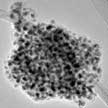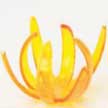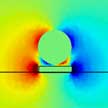Showing Spotlights 153 - 160 of 639 in category All (newest first):
 Researchers report significant advances in developing a high-temperature, fast nanomanufacturing technique for the large-scale production of ultra small metal nanoclusters decorated in a graphene host matrix. The size and morphology of the metal nanoclusters can be controlled by varying the reaction temperature and the mass loading of metal salt in the graphene aerosol nanoreactors. This one-step continuous aerosol-based thermal shock technique offers considerable potential for the manufacturing of well-dispersed and uniform nanoclusters stabilized within a host matrix.
Researchers report significant advances in developing a high-temperature, fast nanomanufacturing technique for the large-scale production of ultra small metal nanoclusters decorated in a graphene host matrix. The size and morphology of the metal nanoclusters can be controlled by varying the reaction temperature and the mass loading of metal salt in the graphene aerosol nanoreactors. This one-step continuous aerosol-based thermal shock technique offers considerable potential for the manufacturing of well-dispersed and uniform nanoclusters stabilized within a host matrix.
Feb 4th, 2019
 4D printing allows a 3D printed structure to change its configuration or function with time in response to external stimuli such as temperature, light, water, pH, etc. The basic idea is to manipulate materials at nano and micro levels in order to produce, via 3D printing, materials that can modify their structures over time at the macro level. Based on 4D printing, 3D printed objects from nano- to macroscale can be fabricated as smart devices, metamaterials, and origami for various functional applications in prototype, aerospace, biomedicine, etc.
4D printing allows a 3D printed structure to change its configuration or function with time in response to external stimuli such as temperature, light, water, pH, etc. The basic idea is to manipulate materials at nano and micro levels in order to produce, via 3D printing, materials that can modify their structures over time at the macro level. Based on 4D printing, 3D printed objects from nano- to macroscale can be fabricated as smart devices, metamaterials, and origami for various functional applications in prototype, aerospace, biomedicine, etc.
Jan 31st, 2019
 In a groundbreaking study, researchers have successfully developed a method that could lead to unprecedented advances in computer speed and efficiency. Through this study, researchers successfully developed a method to make a version of biological patterning for nonvolatile memory technology using the M13 bacteriophage - a virus. This possibility leads the way to the nanosecond storage and transfer delays needed to progress modern computing.
In a groundbreaking study, researchers have successfully developed a method that could lead to unprecedented advances in computer speed and efficiency. Through this study, researchers successfully developed a method to make a version of biological patterning for nonvolatile memory technology using the M13 bacteriophage - a virus. This possibility leads the way to the nanosecond storage and transfer delays needed to progress modern computing.
Nov 27th, 2018
 A novel nanoscale additive manufacturing technique termed Nanotribological Printing creates structures through tribomechanical and tribochemical surface interactions at the contact between a substrate and an atomic force microscope probe, where material pattern formation is driven by normal and shear contact stresses. This technique advances the field of nanomanufacturing by providing a versatile and easily accessible method for creating complex (multi-material) nanostructures, with high precision and uniquely superior mechanical properties.
A novel nanoscale additive manufacturing technique termed Nanotribological Printing creates structures through tribomechanical and tribochemical surface interactions at the contact between a substrate and an atomic force microscope probe, where material pattern formation is driven by normal and shear contact stresses. This technique advances the field of nanomanufacturing by providing a versatile and easily accessible method for creating complex (multi-material) nanostructures, with high precision and uniquely superior mechanical properties.
Nov 13th, 2018
 Researchers have developed a new type of optical manipulation method to achieve versatile manipulation of objects with different sizes and types using optical heating. In this new technique, nanoparticles get trapped at temperature hot spots instead of electrical hot spots, which demonstrates a different working mechanism and approach from the traditional optical manipulation techniques. Due to this unique working principle, stable trapping of large metallic nanoparticles and miniscule quantum dots on single nanoantennas with extremely low optical power is achieved.
Researchers have developed a new type of optical manipulation method to achieve versatile manipulation of objects with different sizes and types using optical heating. In this new technique, nanoparticles get trapped at temperature hot spots instead of electrical hot spots, which demonstrates a different working mechanism and approach from the traditional optical manipulation techniques. Due to this unique working principle, stable trapping of large metallic nanoparticles and miniscule quantum dots on single nanoantennas with extremely low optical power is achieved.
Oct 3rd, 2018
 The reorientation of elongated liquid crystalline molecules under the action of the applied electric field is a major physical effect enabling the use of liquid crystals in a variety of applications. To improve liquid crystal devices, new liquid crystal-forming materials are required. Recently, by merging liquid crystals and nanotechnology, a new, non-synthetic way to produce advanced liquid crystal materials was proposed. In short, it was achieved by dispersing various types of nanomaterials in liquid crystals.
The reorientation of elongated liquid crystalline molecules under the action of the applied electric field is a major physical effect enabling the use of liquid crystals in a variety of applications. To improve liquid crystal devices, new liquid crystal-forming materials are required. Recently, by merging liquid crystals and nanotechnology, a new, non-synthetic way to produce advanced liquid crystal materials was proposed. In short, it was achieved by dispersing various types of nanomaterials in liquid crystals.
Sep 4th, 2018
 Nanotechnology researchers now have developed a natural and non-damaging hair surface engineering technique for making hair coloring formulations that do not use any chemical reactions but instead relies only on physical forces acting at a very close range. The same surface engineering approach is applicable to textile microfiber modifications because natural textiles like like wool, silk, cellulose, but also biomimetic synthetic textiles, have similar chemical composition.
Nanotechnology researchers now have developed a natural and non-damaging hair surface engineering technique for making hair coloring formulations that do not use any chemical reactions but instead relies only on physical forces acting at a very close range. The same surface engineering approach is applicable to textile microfiber modifications because natural textiles like like wool, silk, cellulose, but also biomimetic synthetic textiles, have similar chemical composition.
Aug 30th, 2018
 Achieving high-quality crystalline TiO2 films at room-temperature remains one of today's most important technical challenges toward low-cost optoelectronic devices including photovoltaic cells and photocatalytic device architectures. A research team has now demonstrated a simple method for triggering the crystallization of a TiO2 sol-gel precursor at low-energies. With this technique, it is now possible to achieve 90% crystallinity without metallic dopants, at room temperature and in ambient air, using low-power laser-induced photoactivation of an amorphous TiO2 nanoparticle film.
Achieving high-quality crystalline TiO2 films at room-temperature remains one of today's most important technical challenges toward low-cost optoelectronic devices including photovoltaic cells and photocatalytic device architectures. A research team has now demonstrated a simple method for triggering the crystallization of a TiO2 sol-gel precursor at low-energies. With this technique, it is now possible to achieve 90% crystallinity without metallic dopants, at room temperature and in ambient air, using low-power laser-induced photoactivation of an amorphous TiO2 nanoparticle film.
Aug 23rd, 2018
 Researchers report significant advances in developing a high-temperature, fast nanomanufacturing technique for the large-scale production of ultra small metal nanoclusters decorated in a graphene host matrix. The size and morphology of the metal nanoclusters can be controlled by varying the reaction temperature and the mass loading of metal salt in the graphene aerosol nanoreactors. This one-step continuous aerosol-based thermal shock technique offers considerable potential for the manufacturing of well-dispersed and uniform nanoclusters stabilized within a host matrix.
Researchers report significant advances in developing a high-temperature, fast nanomanufacturing technique for the large-scale production of ultra small metal nanoclusters decorated in a graphene host matrix. The size and morphology of the metal nanoclusters can be controlled by varying the reaction temperature and the mass loading of metal salt in the graphene aerosol nanoreactors. This one-step continuous aerosol-based thermal shock technique offers considerable potential for the manufacturing of well-dispersed and uniform nanoclusters stabilized within a host matrix. 
 Subscribe to our Nanotechnology Spotlight feed
Subscribe to our Nanotechnology Spotlight feed





